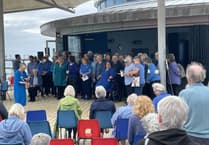The way the Welsh Ambulance Service deals with the most serious 999 calls is changing from Tuesday, 1 July.
A new purple category is being introduced for people suffering from an out-of-hospital cardiac arrest and the red category will be retained for the life-threatening emergencies, those at high risk of cardiac or respiratory arrest, including illnesses and trauma.
The changes are designed to ensure more people get the life-saving help they need from the ambulance service, while those who do not need an ambulance receive more appropriate care for their needs.
They aim to help improve survival rates from out-of-hospital cardiac arrests in Wales, which are currently less than 5%.
The changes are being made in response to a recommendation from the Senedd’s Health and Social Care Committee, which concluded the existing ambulance response target is no longer appropriate or fit for purpose.
The new approach places a greater focus on outcomes than response times.
Jeremy Miles, Cabinet Secretary for Health and Social Care, said: “We're taking decisive action to save more lives.
“Until now, cardiac arrests have been categorised in the same way as less critical problems like breathing difficulties. This new approach ensures ambulance teams prioritise people with the most urgent needs.
“This targeted clinical response, combined with wider access to defibrillators in the community and improvements to hospital handovers, represents our commitment to improving survival rates.”
Jason Killens, chief executive of the Welsh Ambulance Service, said: “Since 1974, the ambulance service has been measured by the time it takes to reach emergency calls.
“The ambulance service of today provides much more sophisticated care, so shifting the focus to how many people survive a life-or-death emergency because of our interventions, rather than how many minutes it takes us to arrive, is an important step to reflect that.”
From Tuesday, 1 July, ambulances will be dispatched to calls in the purple arrest category – people suffering a suspected cardiac and respiratory arrest – and red emergency category – people at high risk of cardiac and respiratory arrest, including as a result of injury and illness – as quickly as possible.
The expectation is that ambulances will respond to these calls in an average of six to eight minutes. But the primary measure for purple calls will be the percentage of people to have a heartbeat restored after a cardiac arrest until arrival at hospital.
As part of the new model, rapid clinical screening will be undertaken for all calls not classified as purple or red. This will ensure every call receives a more tailored approach, which takes account of a person’s symptoms and where the incident occurred. This means every person will receive a tailored response to their needs.
Action will also be taken to improve ambulance handover at hospitals to support ambulance capacity to respond to 999 calls in the community.
The Welsh Government’s response to the Ministerial Advisory Group on NHS Performance and Productivity included developing a plan to assess the readiness of NHS Wales to deliver a maximum 45-minute ambulance patient handover time.
NHS organisations have been set clear expectations to improve ambulance patient handover and are actively working to drive improvements. The Welsh Government has established a national, clinically-led taskforce to support this. It will focus on emergency department processes and patient flow.
From July, the Welsh Ambulance Service will also host the NHS Wales Save a Life Cymru programme to promote CPR awareness and improve accessibility of defibrillators in the community.
This will involve a more joined up approach. There are more than 8,500 registered public access defibrillators in communities throughout Wales, which can help the public play a vital role in improving the chances of survival for people who experience an out-of-hospital cardiac arrest.
The Welsh Government has now provided £500,000 to the Welsh Ambulance Service for an additional 500 Automated External Defibrillators (AEDs) in community locations to support more lives to be saved.




.jpeg?width=209&height=140&crop=209:145,smart&quality=75)
Comments
This article has no comments yet. Be the first to leave a comment.